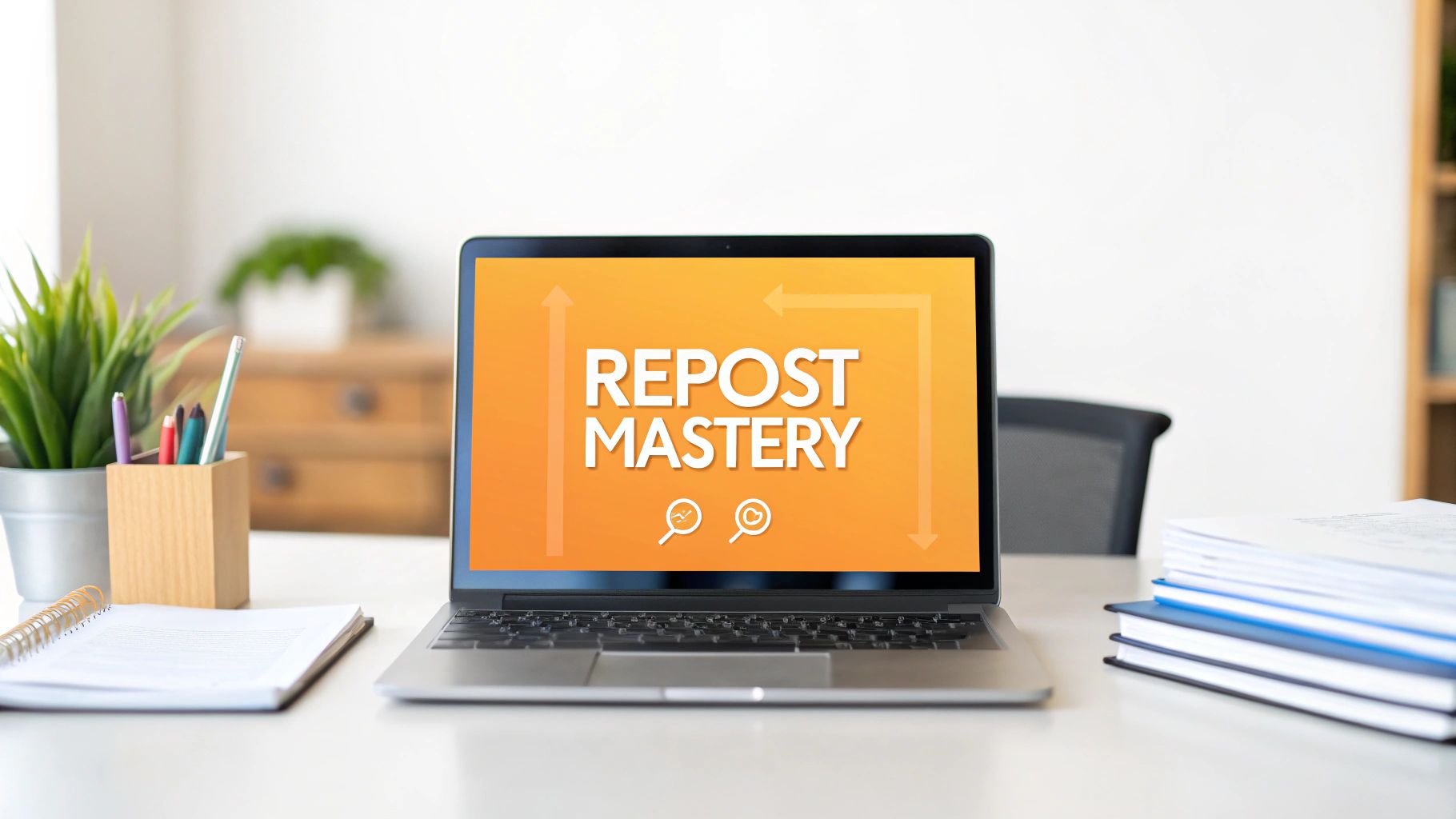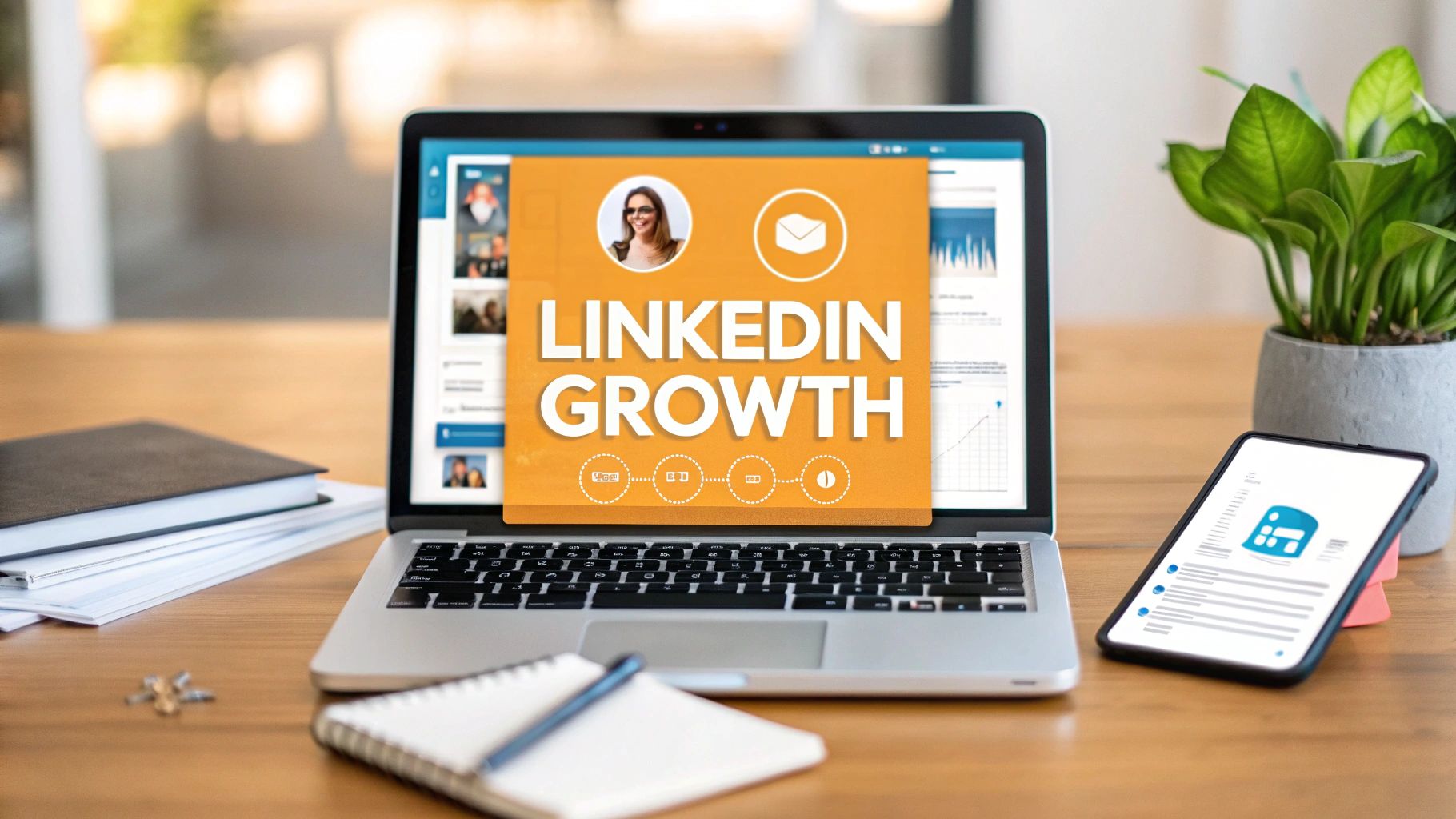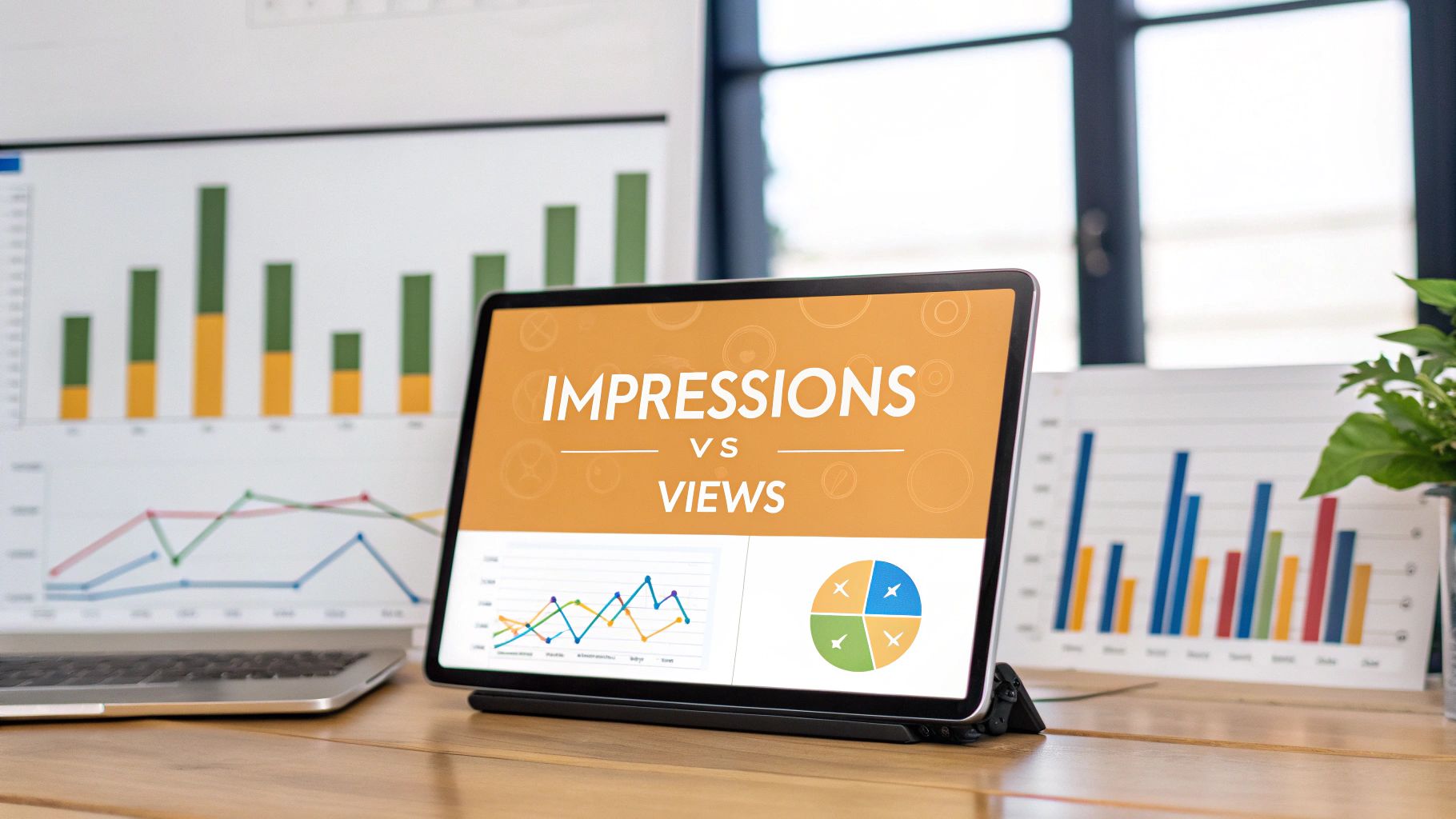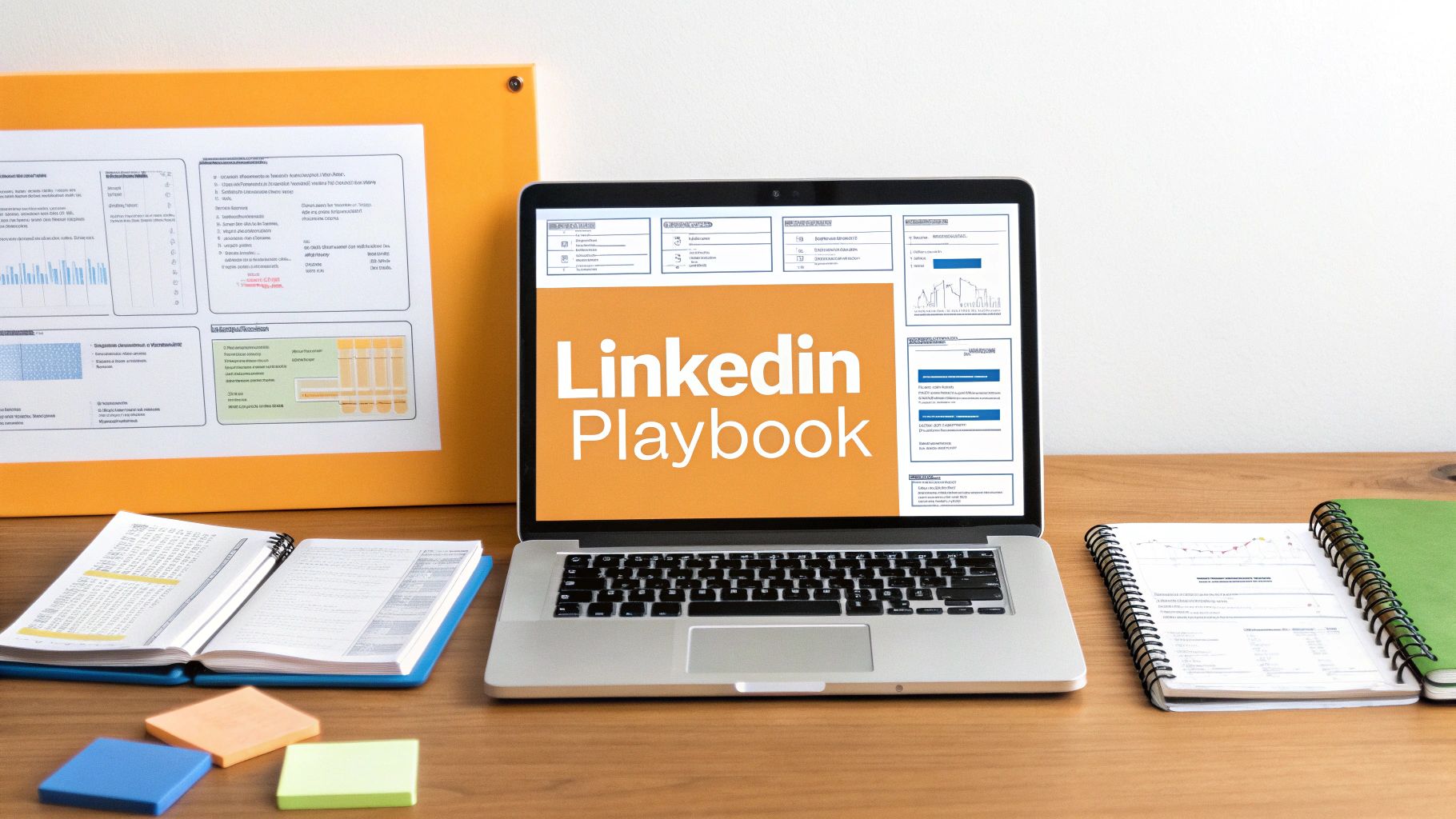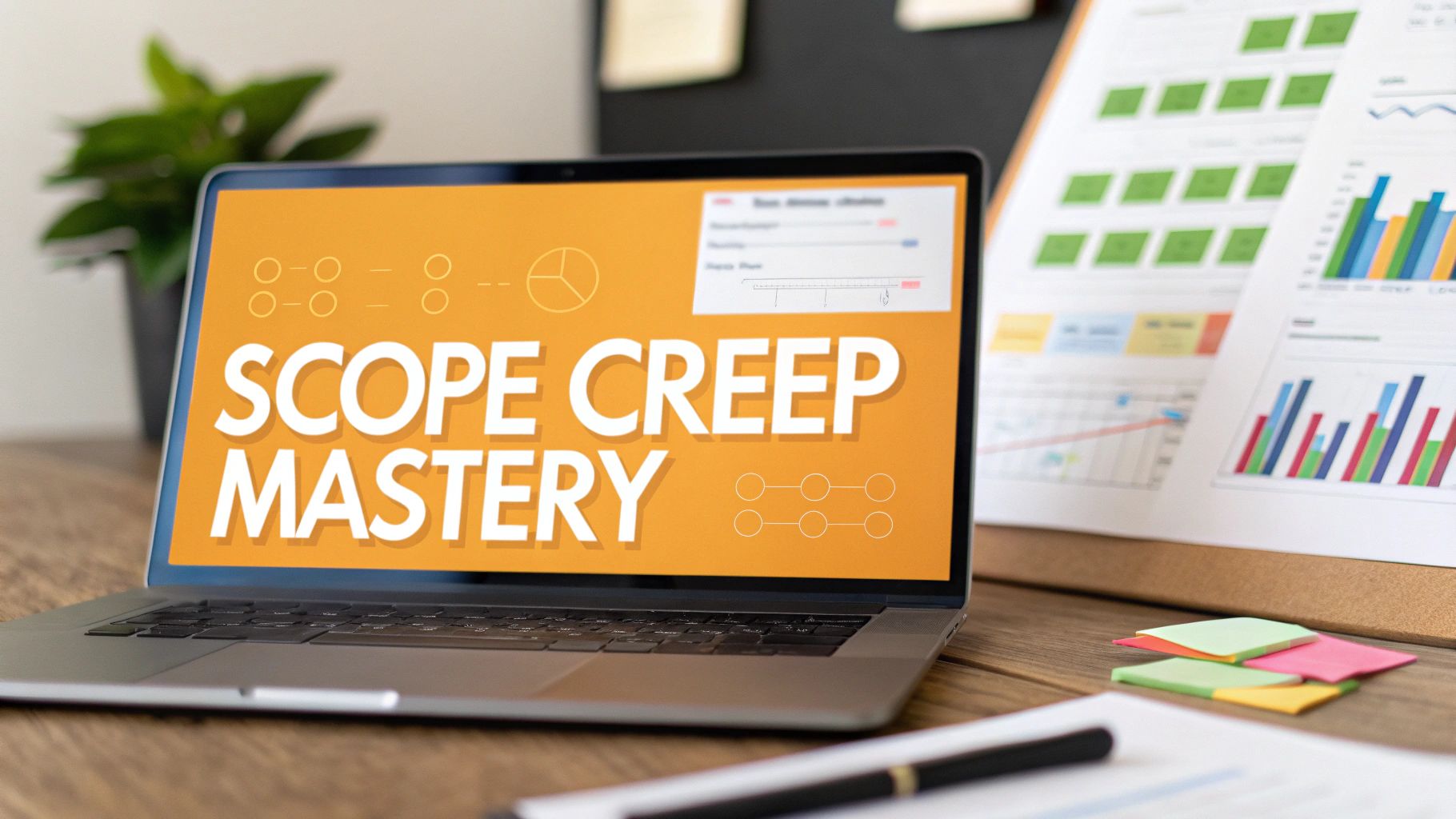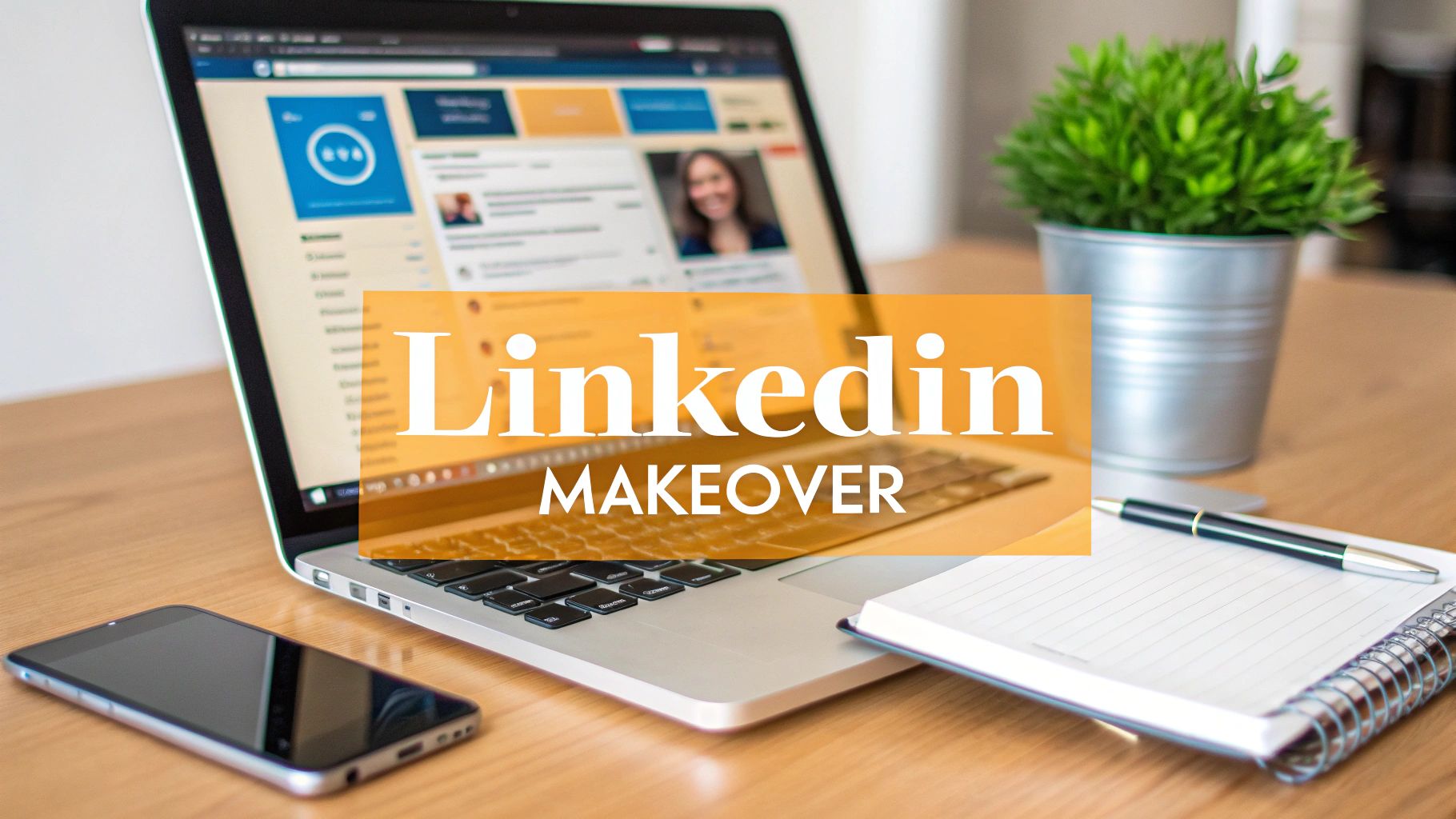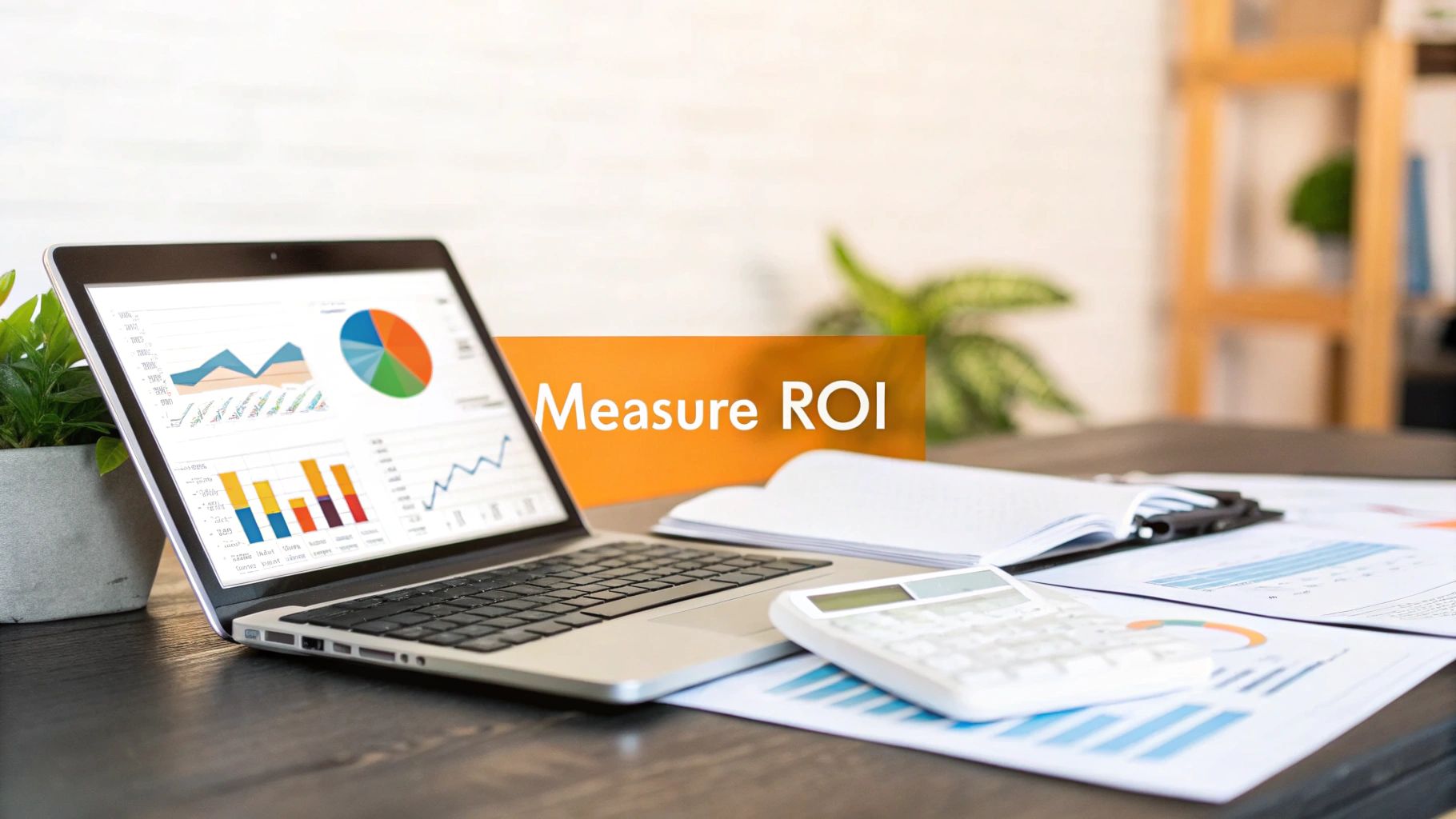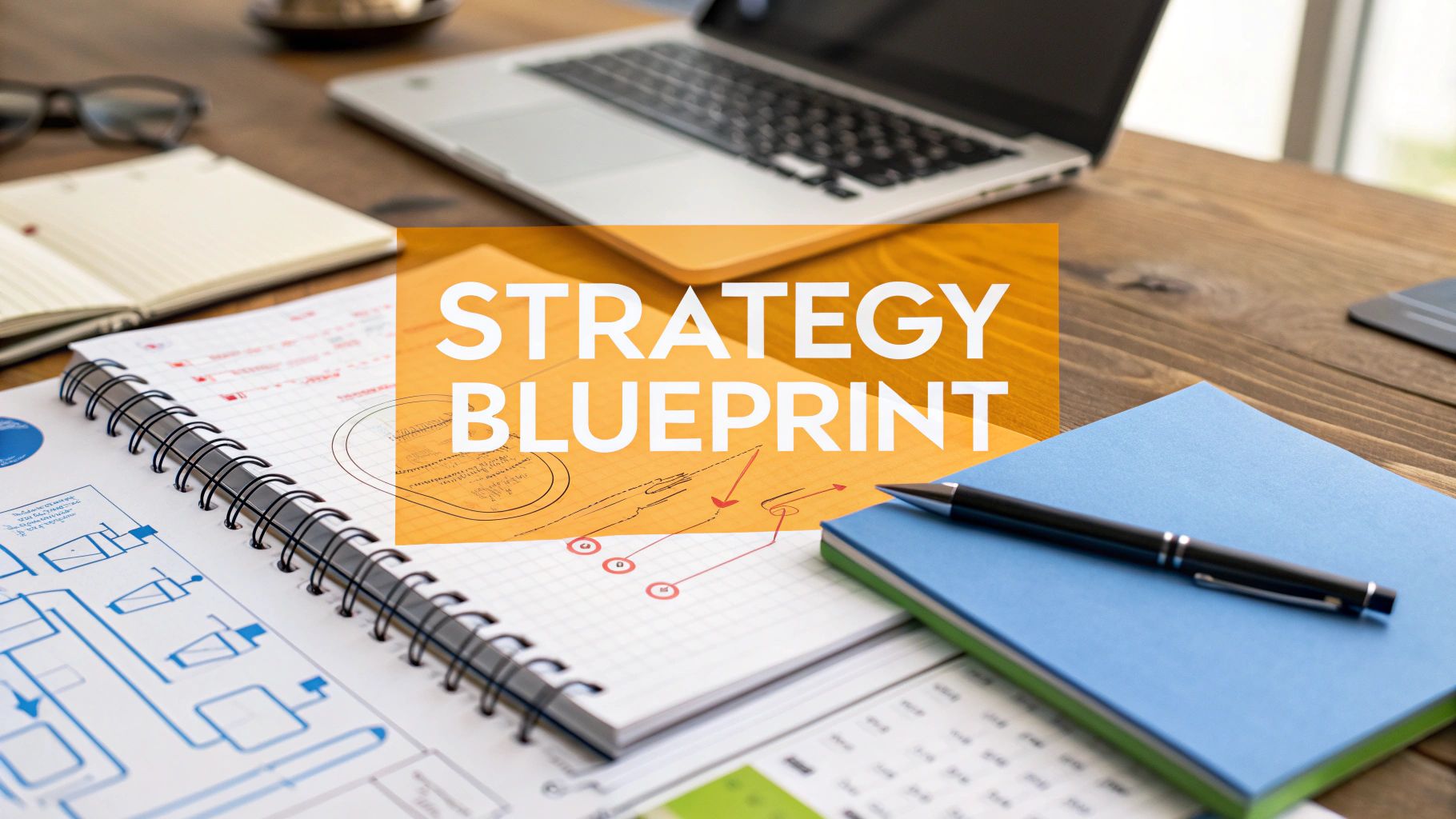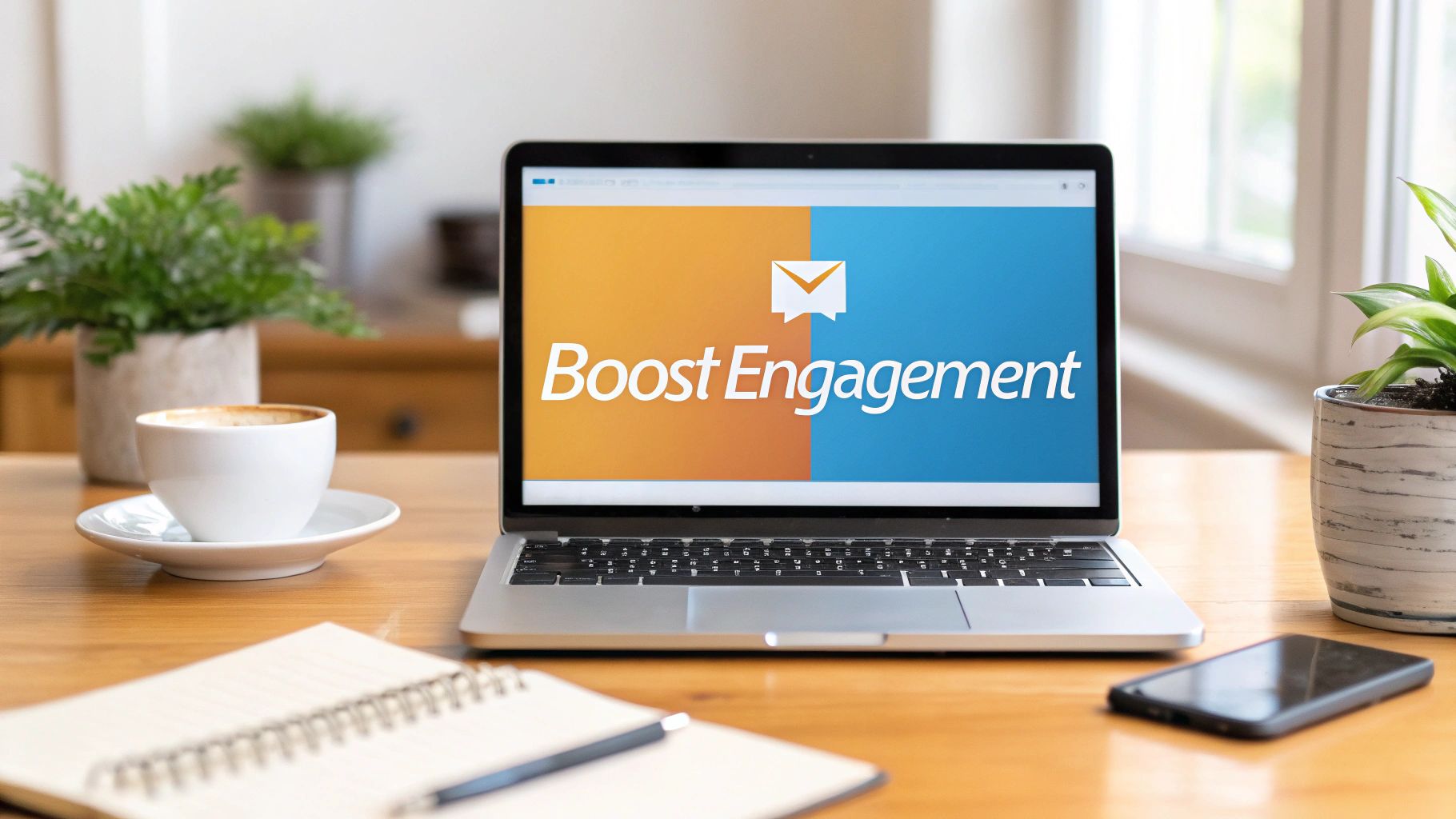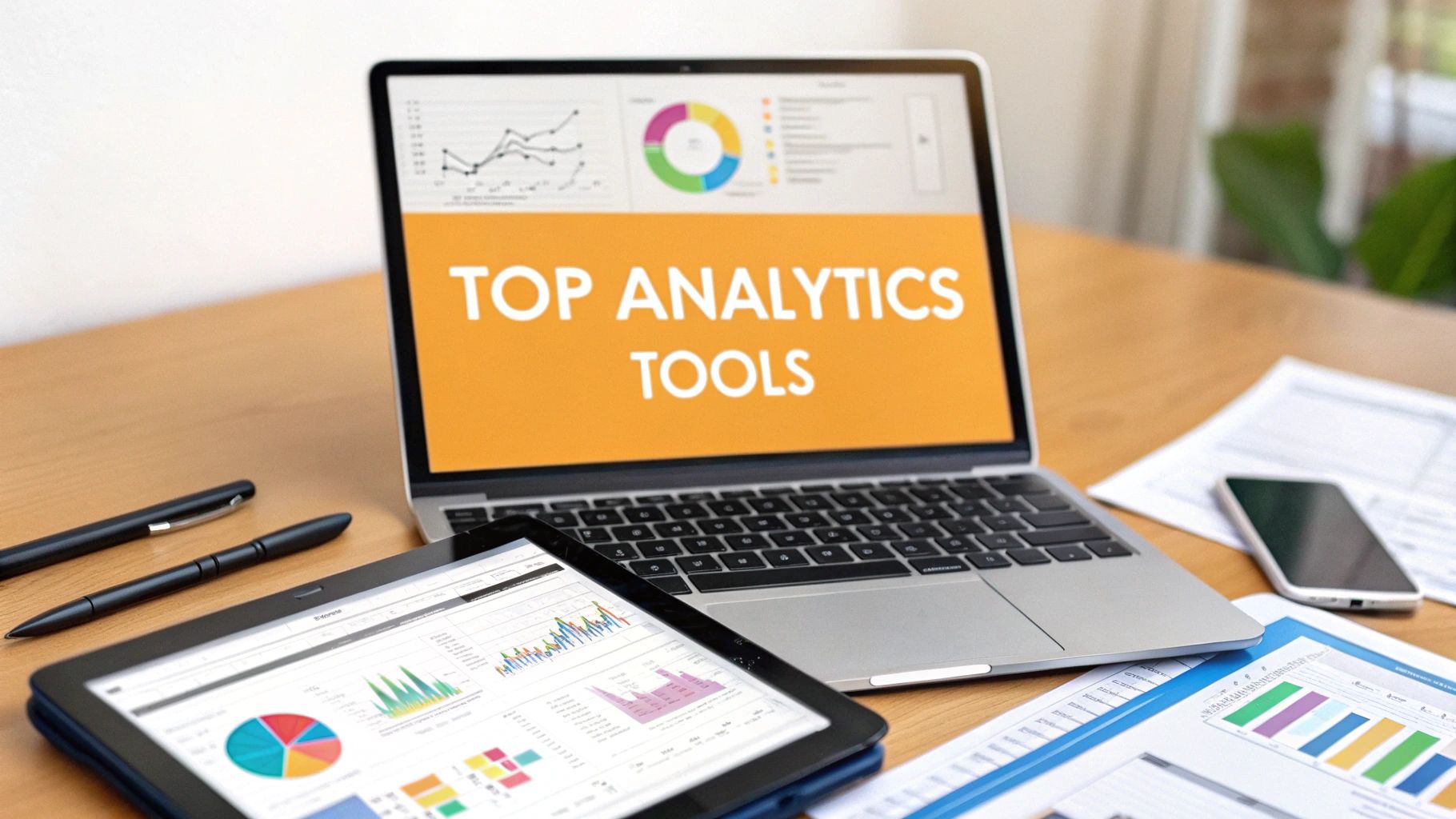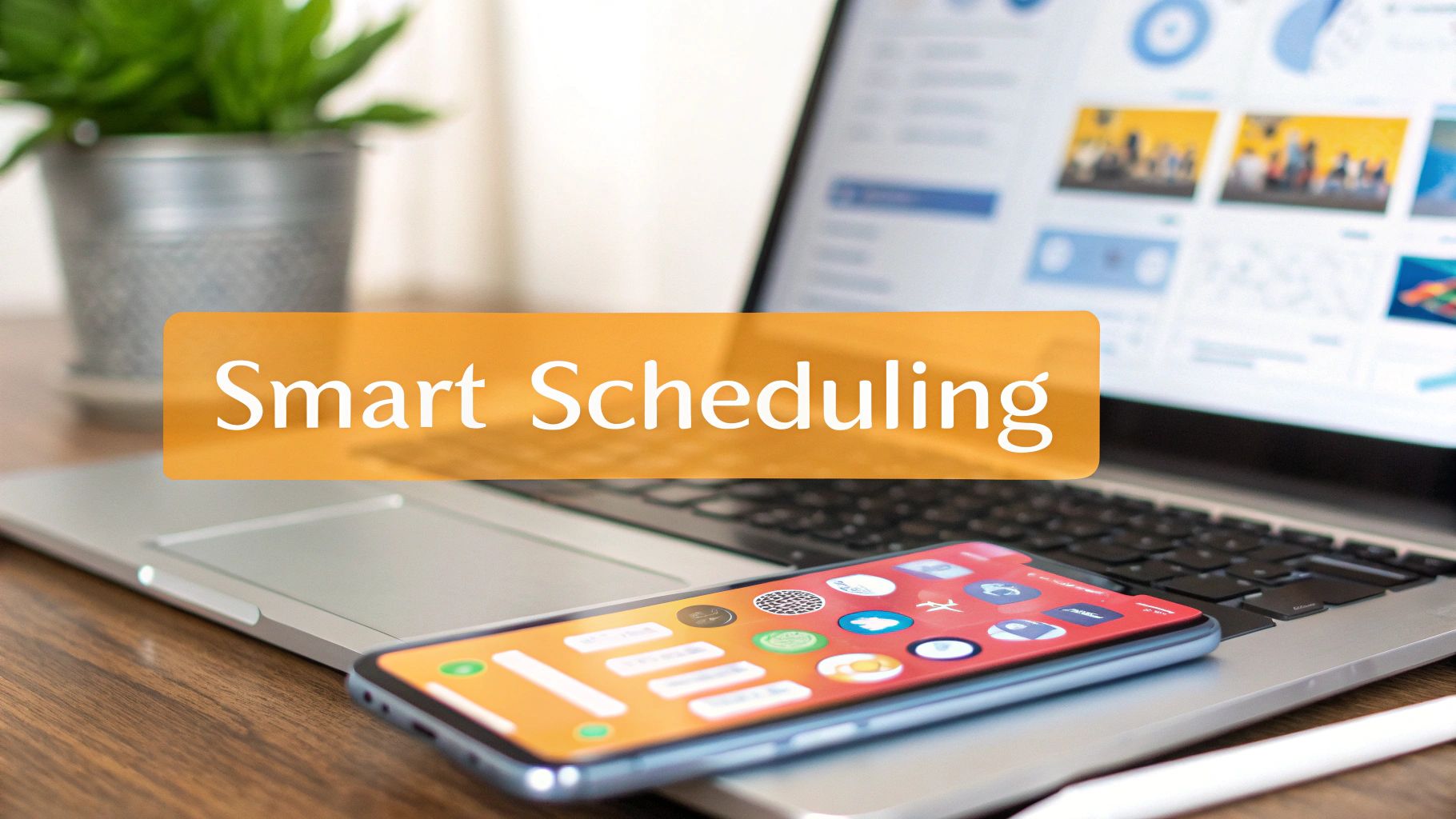So, what exactly is a buyer persona? It's essentially a fictional character you create to represent your ideal customer. But here's the crucial part: this character isn't just made up. It's built from real data and solid market research about your actual audience—their demographics, behaviors, motivations, and goals. You're taking abstract data and turning it into a relatable person.
Why Most Buyer Personas Fail (And How Yours Won't)

Let’s get real for a minute. Most buyer personas are completely useless.
They’re often just a collection of guesses and stereotypes slapped together, resulting in a vague character sketch like, "Meet Marketing Mary. She's 35, likes yoga, and drinks artisanal coffee." This kind of profile is a waste of time. It ends up collecting digital dust in a forgotten Google Drive folder because it doesn't give your team anything real to work with.
The problem is painfully simple: these personas aren't grounded in reality. When your team looks at "Marketing Mary," they don't see a customer with tangible problems. They see a cliché that offers zero help in writing better copy, designing a smarter product, or nailing a sales pitch. It’s fluff, not a strategic tool.
From Vague Guesses to Actionable Insights
The line between a useless persona and a game-changing one is data. A persona built on genuine customer interviews, survey responses, and actual behavioral analytics becomes an indispensable asset. It’s the difference between shouting into a faceless crowd and having a meaningful conversation with someone you truly understand.
When you get this right, you can:
- Craft messaging that actually hits home. You'll know their exact pain points and the language they use to describe them.
- Develop products people genuinely want. Your roadmap will be guided by real user challenges, not just what you think they need.
- Keep your customers coming back. By anticipating their needs, you can create an experience that feels like it was made just for them.
A well-crafted buyer persona isn't just another marketing document; it's a compass for your entire organization. It ensures every single department—from marketing and sales to product and support—is aligned and focused on the same customer.
Building a Foundation That Works
This guide isn't going to hand you another generic template. We’re going to walk through a practical, no-nonsense framework for how to create buyer personas that your team will actually pull up and use every single day. The goal here is to uncover the "why" behind what your customers do.
That means digging into their day-to-day frustrations, their biggest career goals, and what "a win" truly looks like from their perspective. By the end, you won't just have a profile. You'll have a deep, empathetic understanding of the people you’re trying to serve. And that is your real secret weapon for growth.
Gathering the Raw Materials for Your Personas
So, where do great buyer personas come from? They aren't cooked up in a conference room brainstorming session. Not the good ones, anyway. They're built from the ground up with real-world data and genuine human insights. This is the detective work part of the process—where you roll up your sleeves and dig for the clues that will bring your personas to life.
We're going to lean on two different but equally important types of information: quantitative (the "what") and qualitative (the "why"). Think of it this way: quantitative data from your analytics tells you what people are doing on your site, while qualitative insights from conversations tell you why they're doing it. You absolutely need both to get the full picture.
This whole process follows a pretty logical flow, starting with broad data and narrowing down to specific, human feedback.
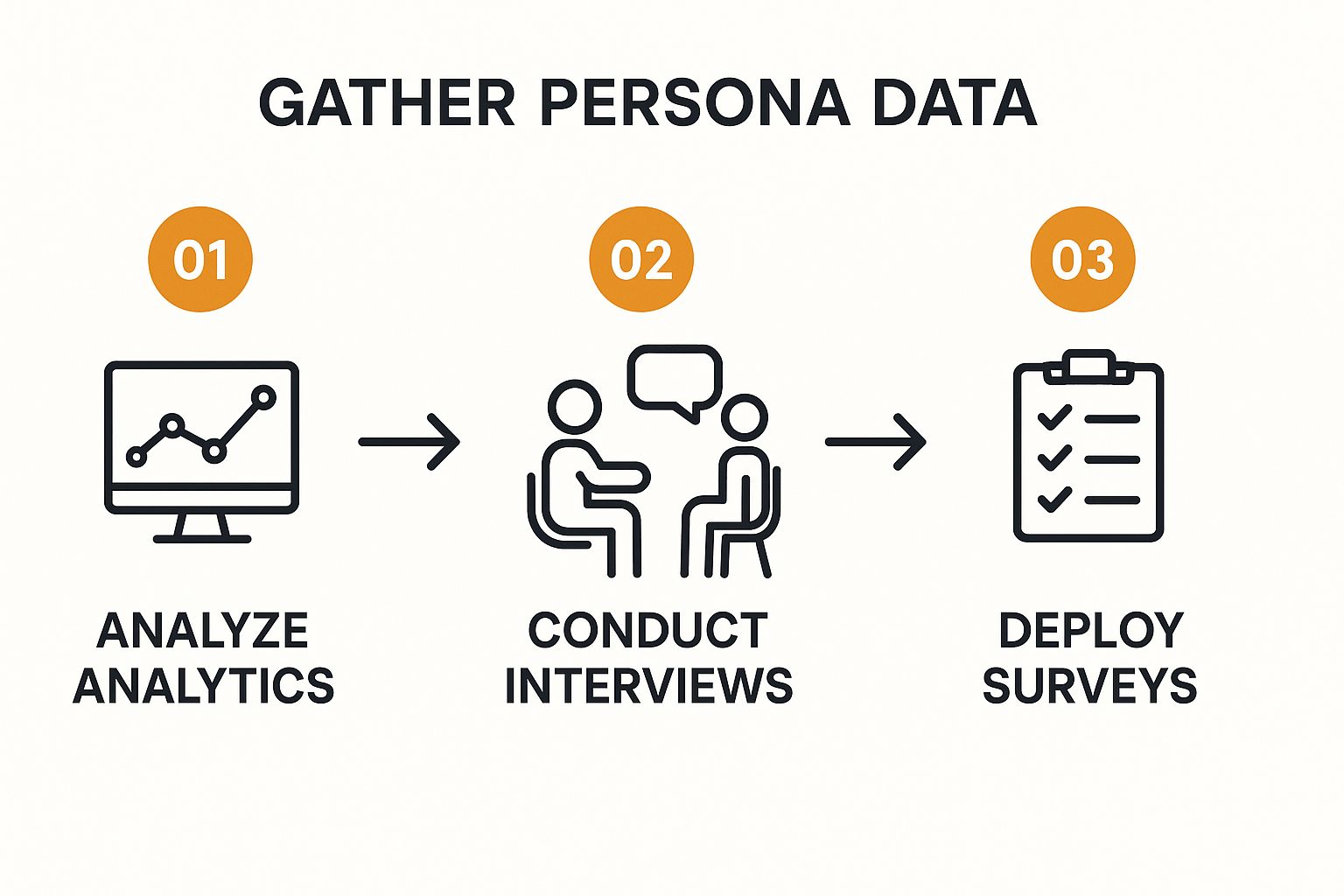
As you can see, you start with the hard numbers, move into deep-dive conversations, and then use surveys to see if your findings hold up at a larger scale.
Start With the Data You Already Have
You’re probably sitting on a goldmine of behavioral data right now. Before you do anything else, dive into the analytics tools you already use. Don't just skim the dashboards—look for the stories hidden in the numbers.
- Google Analytics: Where is your traffic coming from? Which pages or blog posts are getting all the love? Check out the User Flow reports to see the actual paths people take through your site. You might be surprised.
- Social Media Insights: Platforms like LinkedIn and X (formerly Twitter) offer some surprisingly deep demographic data on your followers. Pay attention to job titles, industries, and company sizes. This is a quick way to get a snapshot of who finds your content interesting.
- CRM Data: Your CRM is more than just a contact list. It’s a treasure trove of information about your best customers. Look for common threads—what roles do they have? What was their journey like from lead to happy customer?
Nothing Beats Talking to Real People
Analytics are great, but they can't tell you everything. To really get inside your audience's head, you have to talk to them. This is where you'll uncover the "a-ha" moments that make a persona feel real.
Honestly, one of the most powerful things you can do is interview a handful of your best customers. A simple 20-minute chat can reveal more than weeks of staring at charts. The goal here isn't to sell them anything; it's to understand their world, their challenges, and their goals. A huge part of this is identifying customer pain points—this is the stuff that truly drives purchasing decisions.
Pro Tip: Your interview questions make all the difference. Ditch the yes/no questions. Instead of asking, "Is our price fair?" try something like, "Can you walk me through how you make budget decisions for tools like ours?" One gets you a single word; the other gets you a story.
Finding the Right Data Sources
To build a complete picture, you need to pull information from various places. Relying on just one source, like analytics, will give you a skewed view. Here’s a breakdown of where to look and what to look for.
| Data Source | Type of Data | Key Questions to Answer |
|---|---|---|
| Google Analytics | Quantitative | Where do my visitors come from? Which content do they engage with most? What paths do they take on my site? |
| CRM/Sales Data | Quantitative | What are the common job titles and industries of my best customers? How long is our sales cycle? |
| Customer Interviews | Qualitative | What are their biggest day-to-day challenges? What goals are they trying to achieve? How do they define success? |
| Sales & Support Teams | Qualitative | What are the most common questions you get? What are the biggest objections you have to overcome? |
| Surveys | Both | Do the themes from my interviews apply to a larger audience? What are their preferred channels for information? |
| Social Media Insights | Quantitative | What is the demographic makeup of our followers (age, location, industry)? What content gets the most engagement? |
Ultimately, combining these sources gives you a much richer, more accurate foundation for your personas. You get the hard data from analytics and the human context from conversations.
Use Surveys to Validate Your Hunches
Once your interviews start revealing some common themes, you can use surveys to see if those patterns hold true for a wider audience. This is how you confirm that the challenges mentioned by 5 customers are actually shared by 500.
Just keep your surveys short and to the point. No one wants to fill out a 50-question monster. Focus on your most important questions to maximize your completion rate.
Keep in mind that creating personas is a step beyond just understanding your market. It's about giving that market a human face. For a refresher on the foundational work, our guide on how to identify your target audience is a great place to start.
From Raw Data to a Real-Life Persona Profile

Alright, this is where all that research pays off. You’ve put in the hours, dug through the data, and now you have a pile of interview notes, survey results, and analytics. It's time to connect the dots and shape that raw information into a character so real your team will start talking about them by name.
A word of warning: don't just grab the first template you find on Google and fill in the blanks. That's how you end up with a flat, useless profile that collects digital dust. We’re going for something much more powerful—a story that makes your persona memorable and genuinely useful.
Assembling the Core Components
The first move is to start sorting your data into logical buckets. Think of these as the fundamental building blocks of any solid persona. No matter what business you’re in, these core elements are non-negotiable.
Demographics and Background: This is where you give your persona a name, a face (a stock photo works great), an age, and a job title. Little details like their industry or years of experience add a layer of authenticity that makes them feel less like a concept and more like a person.
Goals and Motivations: What’s their "why"? What are they trying to accomplish in their career or even their personal life? Maybe they're gunning for that next promotion, desperate to streamline a chaotic workflow, or trying to establish themselves as an expert. This is the engine driving their decisions.
Challenges and Pain Points: I'd argue this is the most important part. What keeps them up at night? What are the daily frustrations, the nagging problems, and the roadblocks that stand between them and their goals? A truly effective persona profile paints a vivid picture of these struggles.
Watering Holes: Where do they spend their time? This is your roadmap for reaching them. Figure out which blogs they read, what podcasts are in their queue, which LinkedIn influencers they follow, and what industry conferences they'd never miss.
Building a Persona From Scratch
Let’s walk through building one right now. Say we’ve been analyzing interviews and CRM data for a new project management tool. A clear pattern emerges: the mid-level project manager at a growing tech company.
Let's name her "Project Manager Priya."
Meet Project Manager Priya
- Role: Senior Project Manager at a mid-size SaaS company.
- Age: 34
- Background: She came up through the QA ranks before pivoting to project management about five years ago. She's definitely tech-savvy but isn't a coder.
- Goals: Her primary directive is to ship projects on time and under budget without completely burning out her team. She also has her eye on a Director-level role and wants to impress her boss over the next two years.
- Challenges: Priya feels like she's drowning in admin work. She wastes hours every week chasing down status updates, manually updating spreadsheets, and piecing together reports for leadership.
This is a great start. We have a clear picture of who she is. But to really make her resonate, we need to hear her voice.
"I feel like I spend my entire day just herding cats and updating spreadsheets. I barely have any time left for the strategic planning that actually matters."
A quote like that, pulled directly from a customer interview, is pure gold. It’s real, it’s relatable, and it instantly communicates her biggest frustration. Sprinkling these real-world snippets throughout your profile is how you build genuine empathy with your marketing and sales teams.
Crafting a Day in the Life Narrative
The final step is to weave everything together into a short story. A "day in the life" narrative is the perfect way to show, not just tell, how your persona's challenges and goals play out in the real world.
For instance, Priya’s day probably starts with an inbox that's already overflowing. She bounces from one meeting to the next, trying to get a clear picture of where every project stands. Then, her afternoon is swallowed up by the tedious task of manually building a status report for a VP.
When your team reads that story, they aren't just scanning a list of pain points anymore. They're picturing Priya, feeling her stress, and understanding her urgent need for a better solution. That's how you build a buyer persona that actually drives smarter, more empathetic decisions across the board.
Putting Your Personas to Work Across Your Business

Okay, so you've done the hard work and built out some fantastic buyer personas. That's a huge win, but it’s only the first step. A persona that just gathers dust in a Google Drive folder is completely useless. The real magic happens when you start using it.
This is where all that research turns into a real-world asset that shapes how you make decisions across your entire business. When you really put your personas into practice, they touch everything from the words on your website to the next feature you decide to build.
Imagine a B2B software company discovers its key persona, "Project Manager Priya," is constantly bogged down by administrative tasks. Armed with that insight, they could rewrite their homepage to focus on saving time and cutting out busywork. That one small shift, driven by a persona, could make a massive difference in demo requests.
Fine-Tuning Your Marketing and Sales Game
Think of your personas as the new filter for every single thing your customers see. Instead of blasting out generic messages and hoping something sticks, you can start creating experiences that feel like they were made just for them.
- Content That Clicks: Use your persona’s pain points and goals to guide your content. A solid content marketing strategy guide is a hundred times more effective when you know exactly who you're writing for.
- Smarter Emails: Ditch the one-size-fits-all email blasts. Segment your audience by persona and send them content that actually speaks to their specific world.
- Sales Team Superpowers: Give your sales reps the ultimate cheat sheet. When they know a customer's day-to-day headaches and what they're trying to achieve, they can frame your product as the perfect solution.
This isn't just theory; it works. A fintech banking app dug deep into persona research and found out that most of its users didn't grasp the value of its paid plans. By tailoring their marketing to highlight how specific features solved specific problems for their key personas, they saw a projected 29% revenue increase and a 15% jump in new customers. It's a great example of using buyer personas to accelerate B2B marketing and sales.
A persona isn’t just a profile; it's a decision-making filter. Before you launch anything new, just ask yourself, "What would Priya think of this?"
Making Personas Part of Your DNA
For any of this to work, your personas have to be front and center. Don't hide them away in some forgotten folder.
Share them, print them out, talk about them in meetings. The goal is to make these personas feel like real people who are part of the team. When everyone from marketing to product development feels like they personally know your ideal customer, you'll start seeing incredible results.
By understanding what drives your persona, you learn to speak their language, solve their problems, and build a business they can't help but love.
Alright, you’ve done the hard work of building out your buyer personas. Now what? How do you know if all that effort is actually paying off?
The real proof isn't just a gut feeling; it’s seeing a tangible impact on the metrics that actually matter to your business. It's time to connect the dots between your persona work and your bottom line.
Forget about surface-level stuff like page views. We need to dig into the Key Performance Indicators (KPIs) that show real business impact. When your personas are dialed in, you'll see a noticeable shift in how the right people engage with your brand. This isn't about guesswork—it's about tracking real, measurable improvements.
Identifying Meaningful KPIs
The right KPIs will always tie back to your specific business goals, but they should all point toward deeper engagement and growth. Are you getting more qualified leads? Is your content finally hitting the mark? These are the questions your metrics should be answering.
Here are a few powerful signs that your personas are doing their job:
- Higher Conversion Rates: Take a look at the landing pages you've built specifically for a persona. If a page designed for "Startup Steve" is converting better than your old, generic pages, that’s a clear win.
- Improved Email Engagement: Don't just glance at open rates. Are your segmented email campaigns—the ones targeting specific personas—getting significantly higher click-through rates? That tells you the message is resonating.
- Lower Customer Acquisition Cost (CAC): When you know exactly who you're talking to, your ad spend gets a whole lot smarter. A falling CAC is a strong indicator that you're reaching the right people, right from the start.
The Data-Backed Impact of Personas
This isn't just theory; the numbers consistently show that persona-driven marketing blows generic approaches out of the water.
In fact, companies that use personas in their email marketing can generate up to 18 times more revenue than those just blasting emails to their whole list. The same research points to a 14% improvement in click-through rates and a 10% jump in conversion rates. You can dig into more stats about the power of buyer personas on Salesgenie.com.
The bottom line is simple: companies that obsess over their customers' needs are a staggering 60% more profitable than those that don't. Your personas are the key to unlocking that customer-centric focus.
Refining Personas with Performance Data
Tracking these metrics isn’t just about proving ROI. It’s also your secret weapon for making your personas even more powerful over time.
Think about it: if a campaign aimed at "Marketing Mary" totally bombs, it's not a failure. It's a clue. It's a chance to go back to her profile and figure out why the message fell flat. Did you miss a key pain point? Was the channel wrong?
This data-driven feedback loop is what transforms a static, one-and-done persona into a living, breathing tool that evolves with your audience. It's a continuous cycle of learning, testing, and tweaking. For a deeper dive into this, check out our guide on how to measure content performance.
By consistently tying your persona efforts back to hard data, you ensure they stay accurate, relevant, and incredibly effective for driving growth.
Got Questions About Personas? We've Got Answers
Even with the best templates and a solid plan, a few questions always seem to come up when teams start building out their buyer personas. Let's get ahead of them. These are the little snags that can slow you down, but luckily, the answers are pretty straightforward once you’ve been through this process a few times.
How Many Personas Do I Actually Need?
This is, without a doubt, the number one question I get asked. And the answer is almost always: probably fewer than you think.
It’s so easy to fall into the trap of wanting to create a unique persona for every little difference you spot in your customer base. Before you know it, you've got ten different profiles, and your team can't remember who "Marketing Mary" is versus "Sales Sam."
My advice? Start small. For most companies, one to three core personas will cover the vast majority of your target audience. You want to focus on the big, meaningful differences—the groups with truly distinct goals, challenges, or ways they go about buying something. You can always add another one later if you uncover a completely new segment that just doesn't fit the others.
The point isn't to perfectly capture every single customer. It's to get a deep, meaningful picture of your most important customer types so you can connect with them effectively. If two of your draft personas share 80% of the same problems and motivations, they should probably just be one persona.
What Happens When My Data Doesn't Agree?
Sooner or later, this will happen. Your analytics will show one trend, but your one-on-one interviews will tell a completely different story. First off, don't freak out. This is a good sign! It means you're digging deep enough to find the real-world messiness that simple numbers can’t show you.
When your data seems to conflict, treat it as a flashing sign telling you to dig deeper.
- First, question the numbers. Is there an outlier group in your quantitative data that’s throwing off the averages? Sometimes a small but very active segment can skew the results.
- Then, go back to the people. Use your next round of interviews to ask clarifying questions about the discrepancy you found. The "why" behind the conflict is usually where the gold is.
- When in doubt, trust the human story. Analytics tell you what people are doing, but your conversations tell you why. For building a persona that feels real and helps you create better marketing, the "why" is almost always the more valuable piece of the puzzle.
Conflicting data isn't a roadblock; it’s a clue. It pushes you to challenge your own assumptions and get closer to the truth, which is what this whole persona thing is all about.
Ready to build a powerful personal brand on LinkedIn but feel stuck staring at a blank screen? RedactAI helps you create high-impact posts in minutes by analyzing your unique style and expertise. Join over 21,000 creators and get your first posts generated for free at https://redactai.io.









